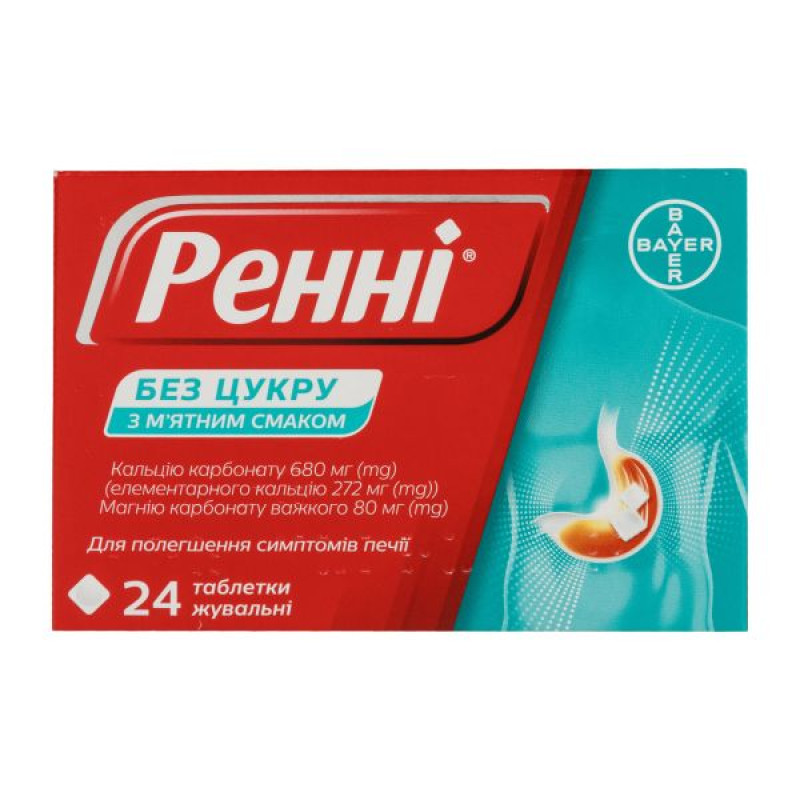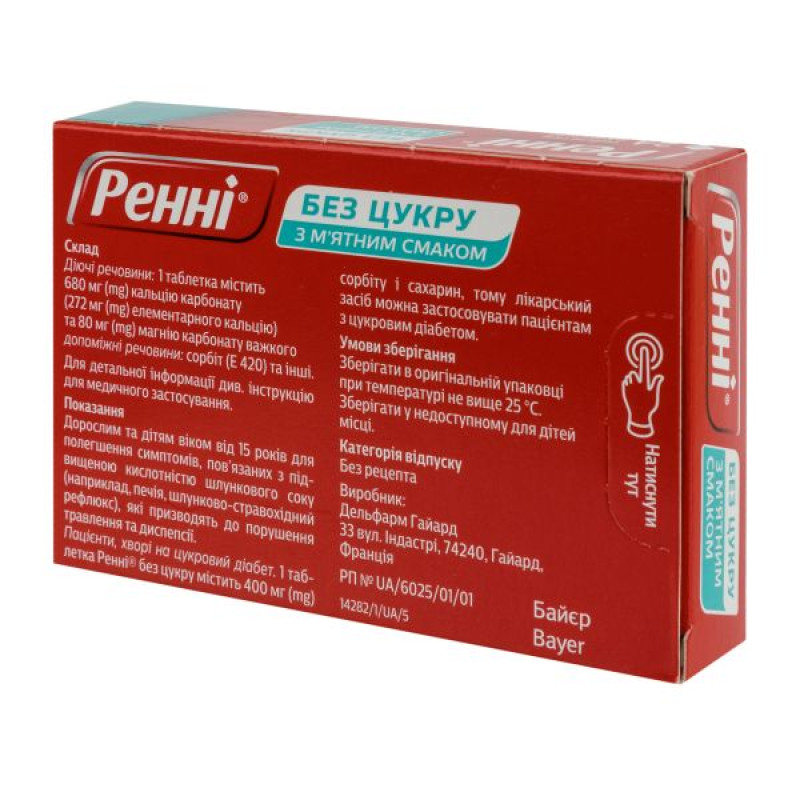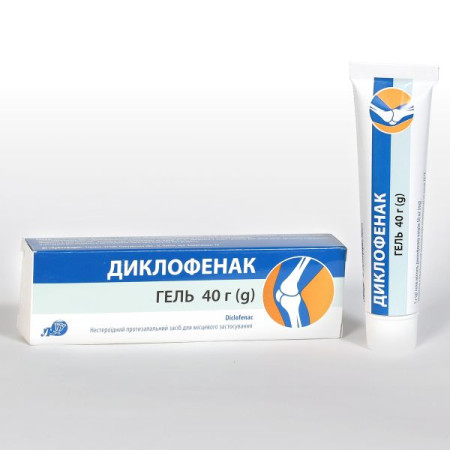Rennie sugar-free chewable tablets blister with mint flavor No. 24

Instructions Rennie sugar-free chewable tablets blister with mint flavor No. 24
Composition
active ingredients: calcium carbonate and heavy magnesium carbonate;
1 tablet contains 680 mg of calcium carbonate (272 mg of elemental calcium) and 80 mg of heavy magnesium carbonate;
excipients: sorbitol (E 420), pregelatinized corn starch, potato starch, talc, magnesium stearate, light mineral oil, mint flavoring, sodium saccharin.
Dosage form
Chewable tablets with mint flavor.
Main physicochemical properties: white to cream-colored square tablets with concave surfaces, embossed with "RENNIE" on both sides and with a mint odor.
Pharmacotherapeutic group
Antacids, other combinations.
ATX code A02A X.
Pharmacological properties
Pharmacodynamics
Rennie® Sugar-Free is a combination of two antacids: calcium carbonate and magnesium carbonate, which act locally by neutralizing gastric acid, independent of systemic absorption. Calcium carbonate has a long-lasting and strong neutralizing activity. This effect is enhanced by magnesium carbonate, which also has a strong neutralizing activity. The total neutralizing capacity of the drug in vitro is 16 mEq H+ (titration to an end point of pH 2.5).
Pharmacokinetics
The onset of stomach acid neutralization is quite rapid.
In healthy volunteers, the administration of 2 Rennie® sugar-free tablets on an empty stomach resulted in a significant increase in gastric pH above baseline within the first 2 minutes, and a total increase in gastric pH of more than 1 unit within 5 minutes.
In the stomach, calcium carbonate and magnesium carbonate react with gastric juice to form water and soluble mineral salts. Calcium and magnesium can be absorbed in the form of their soluble salts. The level of absorption of calcium and magnesium from these compounds depends on the dose of the drug. The maximum level of absorption is 10% of calcium and 15-20% of magnesium. In healthy individuals, a small amount of absorbed calcium and magnesium is excreted by the kidneys. If their function is impaired, the level of calcium and magnesium concentration in the blood plasma may increase. In the intestine, insoluble compounds are formed from soluble salts, which are excreted in the feces.
Indication
Adults and children aged 15 years and over to relieve symptoms associated with increased gastric acidity (e.g. heartburn, gastroesophageal reflux) which lead to indigestion and dyspepsia.
Contraindication
This medicine is contraindicated in the following cases:
- increased individual sensitivity to the components of the drug;
- hypercalcemia and/or conditions leading to hypercalcemia;
- nephrolithiasis, caused by the deposition of stones containing calcium;
- severe renal failure (creatinine clearance below 30 ml/min);
- hypophosphatemia.
Interaction with other medicinal products and other types of interactions
It is recommended to take other medications 1-2 hours before or 1-2 hours after taking Rennie® Sugar-Free.
When using Rennie® Sugar-Free with the following drugs, the following time intervals must be observed:
- 2 hours when using antihistamines, atenolol, metoprolol or propanolol, chloroquine, diflunisal, digoxin, diphosphonates, fexofenadine, glucocorticoids (prednisolone and dexamethasone), indomethacin, ketoconazole, phenothiazid neuroleptics, penicillamine, thyroxine;
- 4 hours when using eltrombopag.
In the case of simultaneous use of Rennie® Sugar-Free with antibiotics (tetracyclines, quinolones) and cardiac glycosides (digoxin), phosphates, fluorine compounds and iron-containing products, levothyroxine and eltrombopag, the absorption of the latter decreases.
Thiazide diuretics reduce urinary calcium excretion and increase serum calcium levels. Due to the increased risk of hypercalcemia, serum calcium levels should be monitored regularly during concomitant use of thiazide diuretics.
Application features
The course of treatment with Rennie® Sugar-Free should not exceed 10 days. If symptoms persist, partially persist or worsen after 10 days of treatment, you should consult a doctor for examination and review of the treatment regimen. Rennie® Sugar-Free should not be taken simultaneously with large amounts of milk or dairy products. Long-term use of Rennie® Sugar-Free may increase the risk of kidney stones. When using 4 to 5 tablets per day, the course of treatment should be short, and treatment should be discontinued immediately after the symptoms disappear.
Calcium carbonate and magnesium carbonate should not be used in hypercalciuria. This drug should be used with caution in patients with impaired renal function. If calcium carbonate and magnesium carbonate must be used in these patients, regular monitoring of plasma calcium, phosphorus, and magnesium levels is necessary.
This product contains sorbitol, which should be taken into account by patients with sorbitol intolerance.
For patients with diabetes: 1 tablet of Rennie® sugar-free contains 400 mg of sorbitol and saccharin, so the drug can be used in patients with diabetes.
Use during pregnancy or breastfeeding
To date, no increased risk of fetal malformations has been observed after the administration of calcium carbonate and magnesium carbonate during pregnancy. Rennie® Sugar-Free can be administered during pregnancy if used as directed, but prolonged use of high doses should be avoided. It should also be borne in mind that the presence of magnesium salts may cause diarrhea, and the presence of calcium in high doses used for a long time increases the risk of hypercalcemia with calcification of various organs, including the kidneys.
It should be noted that during pregnancy or breastfeeding, calcium carbonate and magnesium carbonate provide a significant amount of calcium in addition to the amount supplied by food. Therefore, pregnant women should limit the use of Rennie® without sugar to 1 week and, while using the drug, avoid constant consumption of milk (1 l contains up to 1.2 g of elemental calcium) and dairy products to prevent excess calcium, which can lead to the so-called milk-alkali syndrome (Burnet syndrome), which is a rare but serious disease that requires medical attention.
Ability to influence reaction speed when driving vehicles or other mechanisms
Does not affect.
Method of administration and doses
A drug for oral use in adults and children over 15 years of age.
1-2 chewable tablets, as a single dose, to be dissolved or chewed 1 hour after eating, or when pain or heartburn occurs, or before bedtime.
The dose can be increased for a short period to 5 tablets per day.
The duration of treatment should not exceed 10 days (see "Special instructions").
Children.
Do not use in children under 15 years of age.
Overdose
Prolonged use of high doses of calcium carbonate and magnesium carbonate, especially in patients with impaired renal function, may lead to renal failure, hypermagnesemia, hypercalcemia and alkalosis, manifested by gastrointestinal symptoms (nausea, vomiting, diarrhea or constipation) and muscle weakness. In these cases, the drug should be discontinued and adequate fluid intake should be ensured. In severe cases of overdose (e.g., Burnett syndrome), a doctor should be consulted for possible additional rehydration.
Adverse reactions
From the immune system.
Hypersensitivity reactions have been reported very rarely, the clinical manifestations of which may include rash, urticaria, angioedema and anaphylaxis.
From the side of metabolism and nutrition.
In patients, especially with impaired renal function, prolonged use of high doses may lead to hypermagnesemia (when using antacids containing magnesium) or hypercalcemia and alkalosis, which manifests itself in the form of gastric symptoms and muscle weakness.
From the gastrointestinal tract.
Nausea, vomiting, stomach discomfort, and diarrhea may occur.
Musculoskeletal and connective tissue disorders.
Muscle weakness may occur.
Side effects observed only in milk-alkali syndrome (Burnet syndrome): gastrointestinal disorders (ageusia); general disorders (calcinosis and asthenia);
nervous system disorders (headache); kidney and urinary tract disorders (azotemia).
Expiration date
3 years.
Storage conditions
Store in the original packaging at a temperature not exceeding 25 ºС.
Keep out of reach of children.
Packaging
6 tablets in a blister; 2 or 4 blisters in a cardboard box.
12 tablets in a blister; 1 or 2 blisters in a cardboard box.
Vacation category
Without a prescription.
Producer
Delfarm Gaillard/
Delpharm Gaillard.
Address
33 Rue Industrie, 74240, Gaillard, France/
33 rue de l'Industrie, 74240, Gaillard, France.
There are no reviews for this product.
There are no reviews for this product, be the first to leave your review.
No questions about this product, be the first and ask your question.











